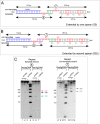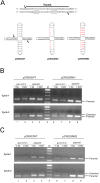Detection and characterization of spacer integration intermediates in type I-E CRISPR-Cas system
- PMID: 24920831
- PMCID: PMC4081107
- DOI: 10.1093/nar/gku510
Detection and characterization of spacer integration intermediates in type I-E CRISPR-Cas system
Abstract
The adaptation against foreign nucleic acids by the CRISPR-Cas system (Clustered Regularly Interspaced Short Palindromic Repeats and CRISPR-associated proteins) depends on the insertion of foreign nucleic acid-derived sequences into the CRISPR array as novel spacers by still unknown mechanism. We identified and characterized in Escherichia coli intermediate states of spacer integration and mapped the integration site at the chromosomal CRISPR array in vivo. The results show that the insertion of new spacers occurs by site-specific nicking at both strands of the leader proximal repeat in a staggered way and is accompanied by joining of the resulting 5'-ends of the repeat strands with the 3'-ends of the incoming spacer. This concerted cleavage-ligation reaction depends on the metal-binding center of Cas1 protein and requires the presence of Cas2. By acquisition assays using plasmid-located CRISPR array with mutated repeat sequences, we demonstrate that the primary sequence of the first repeat is crucial for cleavage of the CRISPR array and the ligation of new spacer DNA.
© The Author(s) 2014. Published by Oxford University Press on behalf of Nucleic Acids Research.
Figures





References
-
- Barrangou R., Fremaux C., Deveau H., Richards M., Boyaval P., Moineau S., Romero D.A., Horvath P. CRISPR provides acquired resistance against viruses in prokaryotes. Science. 2007;315:1709–1712. - PubMed
-
- Al-Attar S., Westra E.R., van der Oost J., Brouns S.J. Clustered regularly interspaced short palindromic repeats (CRISPRs): the hallmark of an ingenious antiviral defense mechanism in prokaryotes. Biol. Chem. 2011;392:277–289. - PubMed
-
- Sorek R., Lawrence C.M., Wiedenheft B. CRISPR-mediated adaptive immune systems in bacteria and archaea. Annu. Rev. Biochem. 2013;82:237–266. - PubMed
-
- Mojica F.J., Diez-Villasenor C., Garcia-Martinez J., Soria E. Intervening sequences of regularly spaced prokaryotic repeats derive from foreign genetic elements. J. Mol. Evol. 2005;60:174–182. - PubMed
-
- Jore M.M., Lundgren M., van Duijn E., Bultema J.B., Westra E.R., Waghmare S.P., Wiedenheft B., Pul U., Wurm R., Wagner R., et al. Structural basis for CRISPR RNA-guided DNA recognition by Cascade. Nat. Struct. Mol. Biol. 2011;18:529–536. - PubMed
Publication types
MeSH terms
Substances
LinkOut - more resources
Full Text Sources
Other Literature Sources
Molecular Biology Databases

